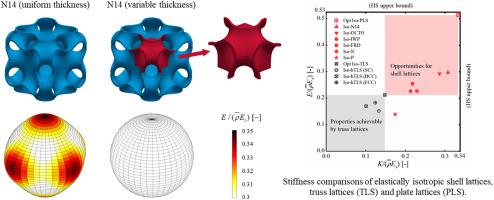Additive Manufacturing ( IF 10.3 ) Pub Date : 2021-09-11 , DOI: 10.1016/j.addma.2021.102293 Qingping Ma 1 , Lei Zhang 1 , Junhao Ding 2 , Shuo Qu 2 , Jin Fu 3 , Mingdong Zhou 4 , Ming Wang Fu 3 , Xu Song 2 , Michael Yu Wang 1

|
Triply periodic minimal surface (TPMS) shell lattices are attracting increasingly attention due to their unique combination of geometric and mechanical properties, and their open-cell topology. However, uniform thickness TPMS shell lattices are usually anisotropic in stiffness, namely having different Young’s moduli along different lattice directions. To reduce the elastic anisotropy, we propose a family of variable thickness TPMS shell lattices with isotropic stiffness designed by a strain energy-based optimization algorithm. The optimization results show that all the six selected types of TPMS lattices can be made to achieve isotropic stiffness by varying the shell thickness, among which N14 can maintain over 90% of the Hashin-Shtrikman upper bound of bulk modulus. All the optimized shell lattices exhibit superior stiffness properties and significantly outperform elastically-isotropic truss lattices of equal relative densities. Both uniform and optimized types of N14 shell lattices along [100], [110] and [111] directions are fabricated by the micro laser powder bed fusion techniques with stainless steel 316 L and tested under quasi-static compression loads. Experimental results show that the elastic anisotropy of the optimized N14 lattices is reduced compared to that of the uniform ones. Large deformation compression results reveal different failure deformation behaviors along different directions. The [100] direction shows a layer-by-layer plastic buckling failure mode, while the failures along [110] and [111] directions are related to the shear deformation. The optimized N14 lattices possess a reduced anisotropy of plateau stresses and can even attain nearly isotropic energy absorption capacity.
中文翻译:

通过可变厚度设计具有优异刚度的弹性各向同性开孔最小表面壳晶格
三重周期性最小表面 (TPMS) 壳晶格由于其独特的几何和机械特性组合以及它们的开孔拓扑结构而越来越受到关注。然而,均匀厚度的 TPMS 壳晶格通常具有各向异性的刚度,即沿不同晶格方向具有不同的杨氏模量。为了减少弹性各向异性,我们提出了一系列具有各向同性刚度的可变厚度 TPMS 壳晶格,其由基于应变能的优化算法设计。优化结果表明,通过改变壳厚度,所有六种选定类型的 TPMS 晶格都可以实现各向同性刚度,其中 N14 可以保持 90% 以上的体积模量的 Hashin-Shtrikman 上限。所有优化的壳晶格都表现出优异的刚度特性,并且明显优于具有相同相对密度的弹性各向同性桁架晶格。沿 [100]、[110] 和 [111] 方向的均匀和优化类型的 N14 壳晶格都是通过微激光粉末床融合技术与不锈钢 316 L 制造的,并在准静态压缩载荷下进行测试。实验结果表明,优化后的 N14 晶格的弹性各向异性比均匀晶格的弹性各向异性有所降低。大变形压缩结果揭示了沿不同方向的不同破坏变形行为。[100]方向为逐层塑性屈曲破坏模式,而沿[110]和[111]方向的破坏与剪切变形有关。











































 京公网安备 11010802027423号
京公网安备 11010802027423号